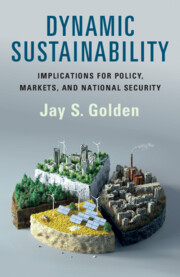Book contents
- Dynamic Sustainability
- Reviews
- Dynamic Sustainability
- Copyright page
- Dedication
- Contents
- About the Author
- Preface
- Acknowledgments
- Abbreviations
- Part I Introduction and Global Trends
- 1 Introducing Dynamic Sustainability
- 2 Global Trends
- 3 Global Climate Change
- Part II Net-Zero-Carbon Transitions
- Part III Dynamics of the Transition
- Part IV Finance and the Transition
- Part V Wrap Up and What Is Next
- Index
- References
1 - Introducing Dynamic Sustainability
from Part I - Introduction and Global Trends
Published online by Cambridge University Press: 07 December 2023
- Dynamic Sustainability
- Reviews
- Dynamic Sustainability
- Copyright page
- Dedication
- Contents
- About the Author
- Preface
- Acknowledgments
- Abbreviations
- Part I Introduction and Global Trends
- 1 Introducing Dynamic Sustainability
- 2 Global Trends
- 3 Global Climate Change
- Part II Net-Zero-Carbon Transitions
- Part III Dynamics of the Transition
- Part IV Finance and the Transition
- Part V Wrap Up and What Is Next
- Index
- References
Summary
This chapter offers a high-level overview of some of the global drivers of dynamic sustainability.
- Type
- Chapter
- Information
- Dynamic SustainabilityImplications for Policy, Markets and National Security, pp. 3 - 14Publisher: Cambridge University PressPrint publication year: 2023

